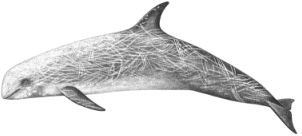Dolphins & Whales in Greece
Cetaceans – the biological order to which whales, dolphins and porpoises belong – appear on many ancient wall paintings, pottery, coins, jewellery etc. In fact, these marine mammals have been a part of Greek civilisation for over three and a half thousand years and the science of cetology was indeed founded by the ancient Greeks. The first scientific report on dolphins and whales is Historia Animalium written by Aristotle, and dates back to 350 BCE.
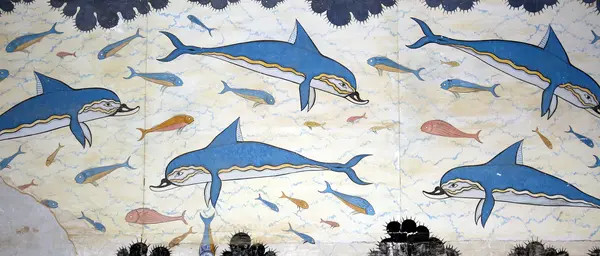
To correctly identify the four most commonly sighted dolphins, as well as the four most commonly sighted whales in these waters, their characteristics are outlined below.
A handy Identification Guide, as well as a Test Your Knowledge Quiz can be found towards the end of this page.
Striped dolphin
The Striped dolphin Stenella coeruleoalba is named after its dark bluish-black stripe running across the entire length of the body.
In the east Mediterranean the Striped dolphin is the most common and most sighted dolphin and here they seem to prey primarily on cephalopods
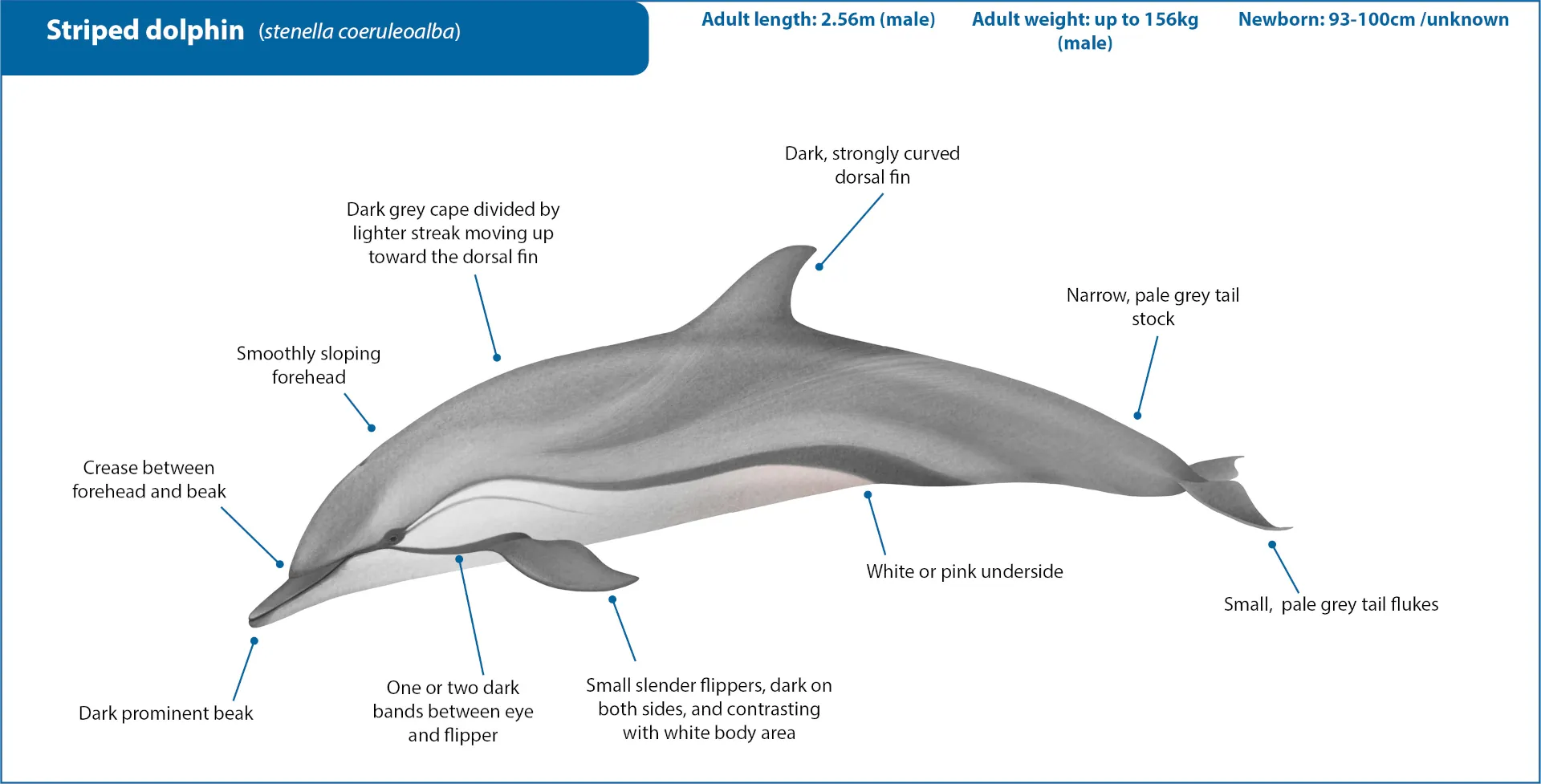
- Up to 2 metres long
- Evident beak
- Dark grey to light grey with black stripes from eyes to flippers, light flame on flanks
- The most common dolphin in Greece
Striped dolphins are very active, performing aerial manoeuvres like breaching chin slaps, bow-riding and a unique behaviour called “roto-tailing” in which they make high arcing jumps while violently and rapidly performing several rotations before re-entering the water.
Listen to the
♫ sounds of a striped dolphin.
Common dolphin
The classical Greek dolphin; since 1994 there are two recognised forms: The Common dolphin Delphinus capensis and the Short-beaked common dolphin Delphinus delphis.
They prey on schooling fish (e.g. herring, pilchards) and squid. They have been known to adopt co-operative techniques when hunting.
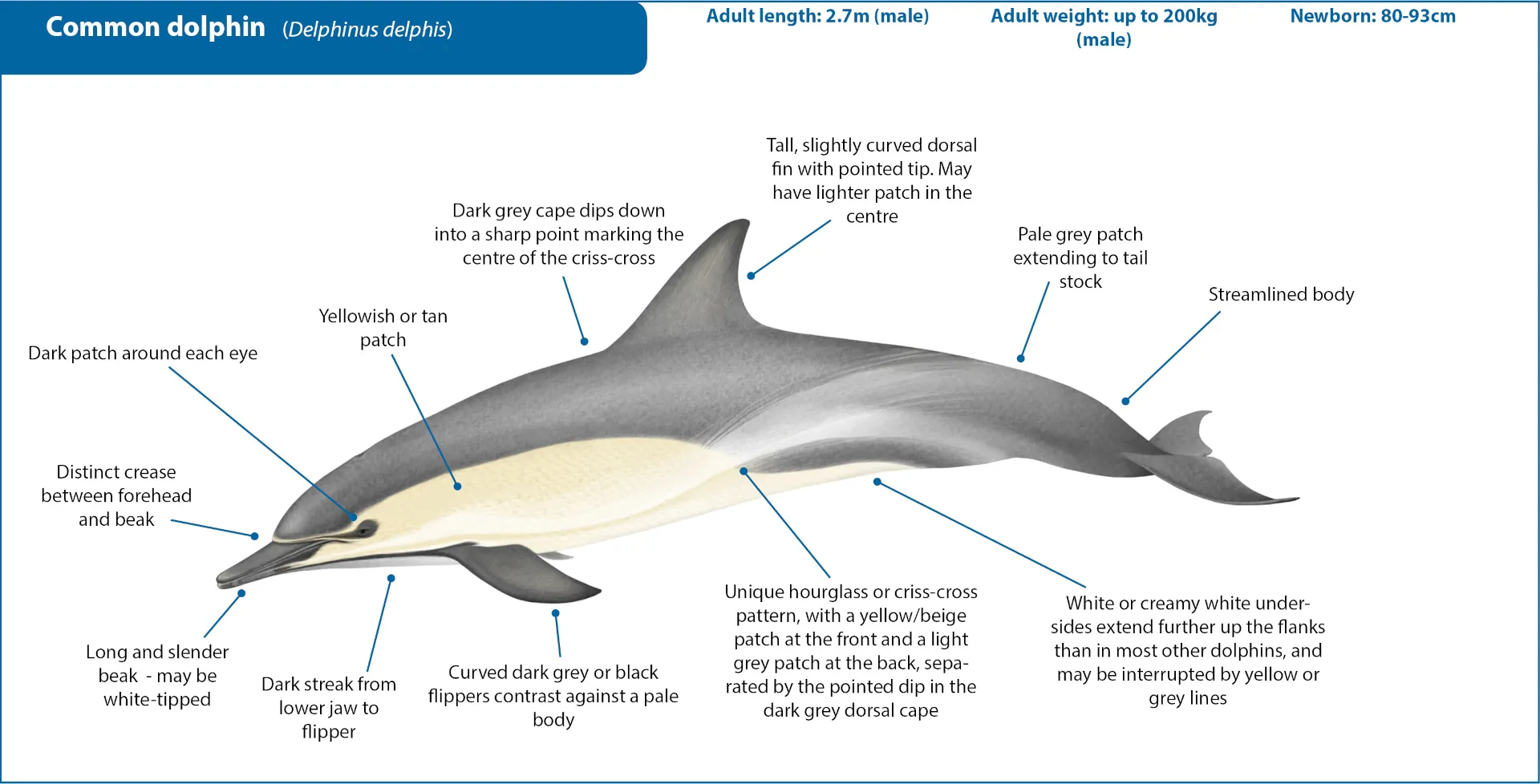
- Up to 2 metres long with evident beak
- Downward V-shaped dark mark under the dorsal fin, black to dark grey-back with a variable lighter area in the dorsal fin and lighter flanks
- Now rare, prefers coastal waters
Active and exuberate, they bow ride, breach, somersault, flipper-slap and lob tail When porpoising they often cannot be seen for the froth they produce; they leap as a co-ordinated whole. Also highly vocal, their cries – whistles, pulses and clicks – can be heard above water as they play around vessels.
Risso's dolphin
Risso's Dolphins Grampus griseus vary in colour from blue-grey, grey-brown or almost-white, depending on age and injuries and can easily be identified by their bulging forehead. Also, scars from other male Risso's Dolphins can often be seen, dark on lighter individuals and light on darker individuals.
Their main prey is squid and octopi but they are also known to take fish.
Don't steer the yacht towards the pod (they are often not interested in sailing boats or bow riding), but allow the animals to take the initiative themselves.
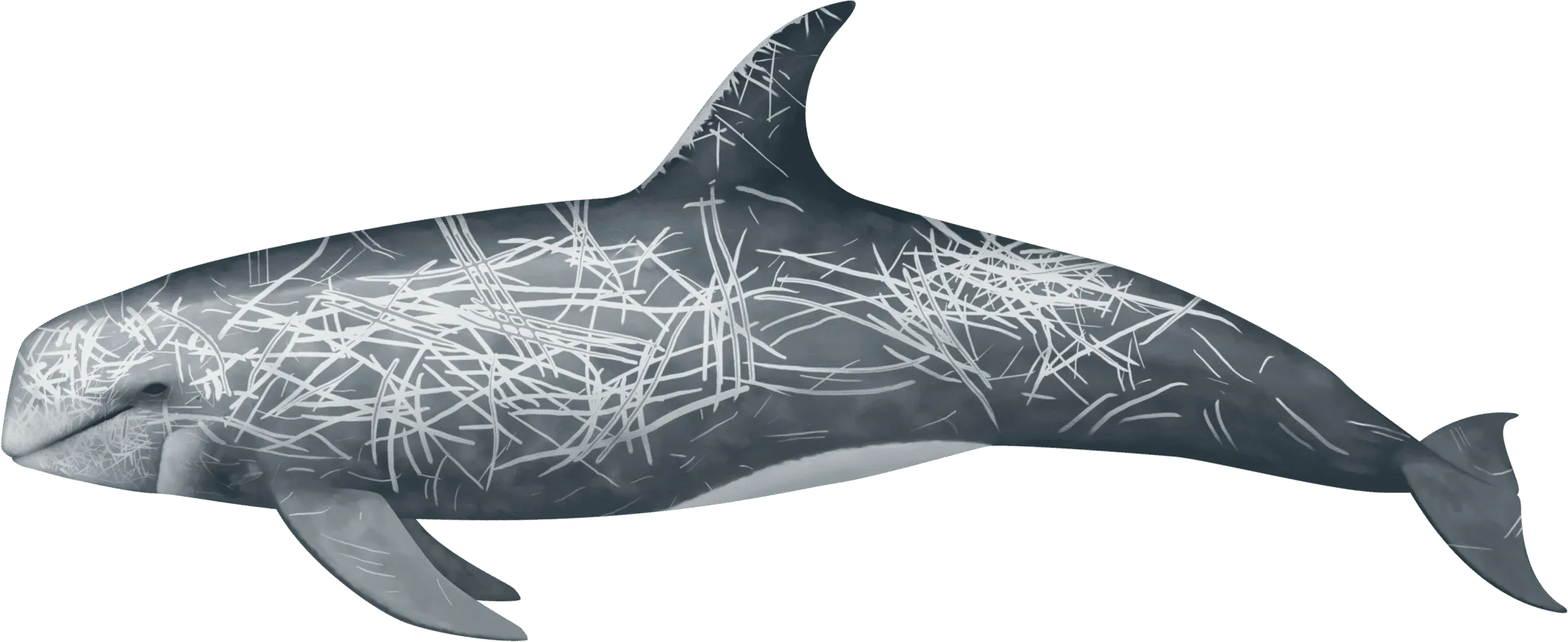
- Up to 3.5 metres long
- Rounded head and “barrel-shaped” body
- Coloured in a range of greys with white scars, older individuals might get almost completely white
- Tall falcate dorsal fin

Risso's Dolphins are usually seen in groups of 3 – 30 animals, and often mix with other dolphin species. They often surface leisurely side-by-side but when moving quickly are aerial acrobats and often breach, bowride and porpoise. Risso's Dolphins produce a series of varying sounds including signature whistles: listen to ♫ sounds of a Risso's dolphin.
Bottlenose dolphin
The Bottlenose Dolphin Tursiops truncatus – the archetypical “Flipper” – tends to prefer shoaling and bottom-dwelling species, feasting upon a wide variety of (cuttle)fish, squid and octopi. Also, they often hunt as a team, herding small fishes such as menhaden ahead of them and picking off the stragglers.
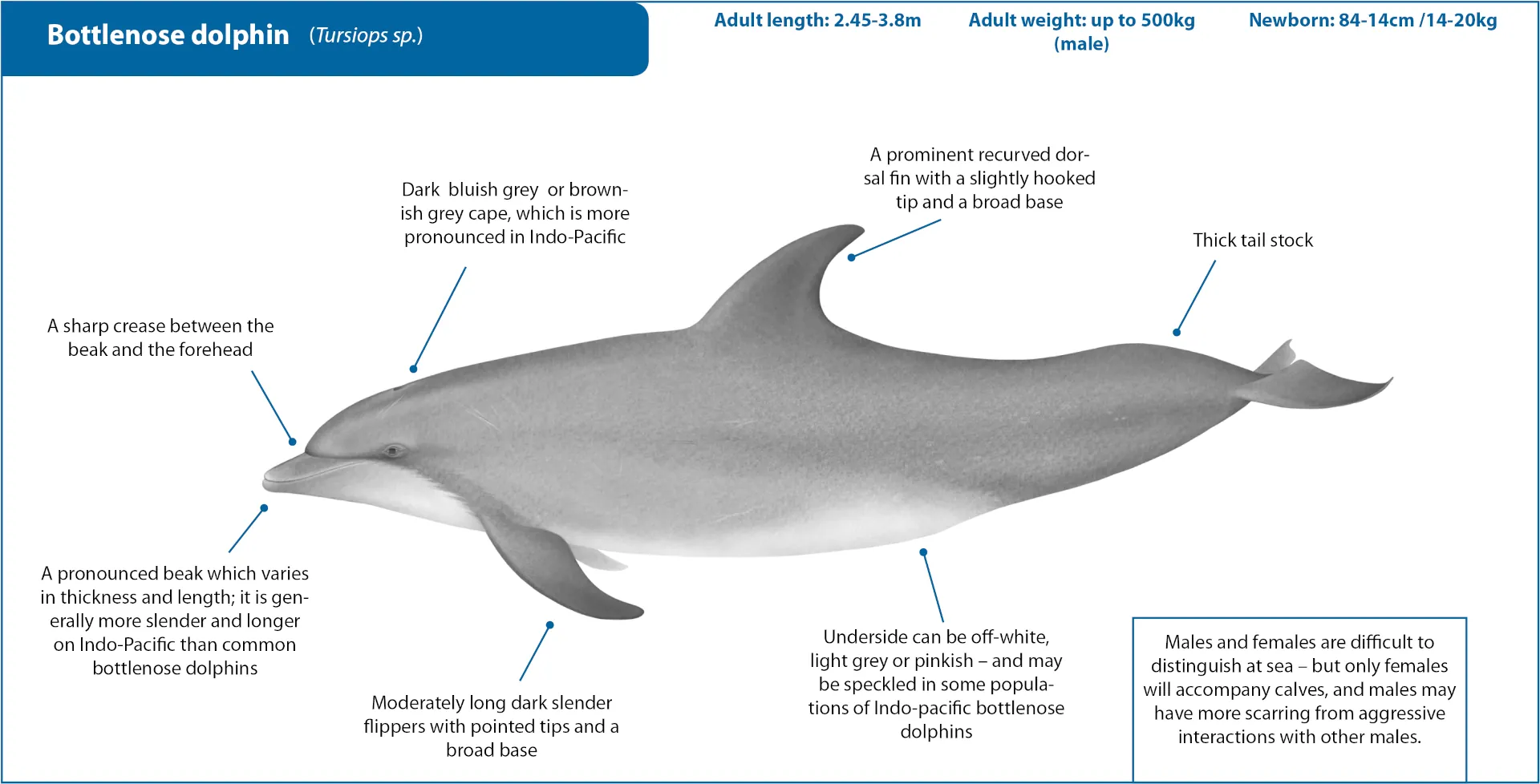
- Up to 3 metres long
- Robust head with short beak
- Grey to brown-black with lighter flanks
- Prefers coastal waters
Bottlenose Dolphins are a distinctly social species, usually travelling in groups of as many as a dozen, but they have been seen in aggregations of several hundred. They are powerful swimmers and acrobatic in nature, often bow riding and leaping alongside vessels. Tursiops truncatus displays a complex language that people may eventually be able to use to communicate meaningfully with dolphins. Each dolphin appears to have its own distinctive whistle by which it communicates a limited amount of information on its identity, location, and condition to other dolphins.
Pilot whale
The Pilot Whale Globicephala melas
is an active hunter feeding on fish and squids.
This species is a fairly stocky whale, with a low, rounded dorsal fin that is set one-third of the way along the body, and with long pectoral fins. Despite its name this whale belongs to the dolphin family – the Delphinidae – just like killer whales and beaked whales.
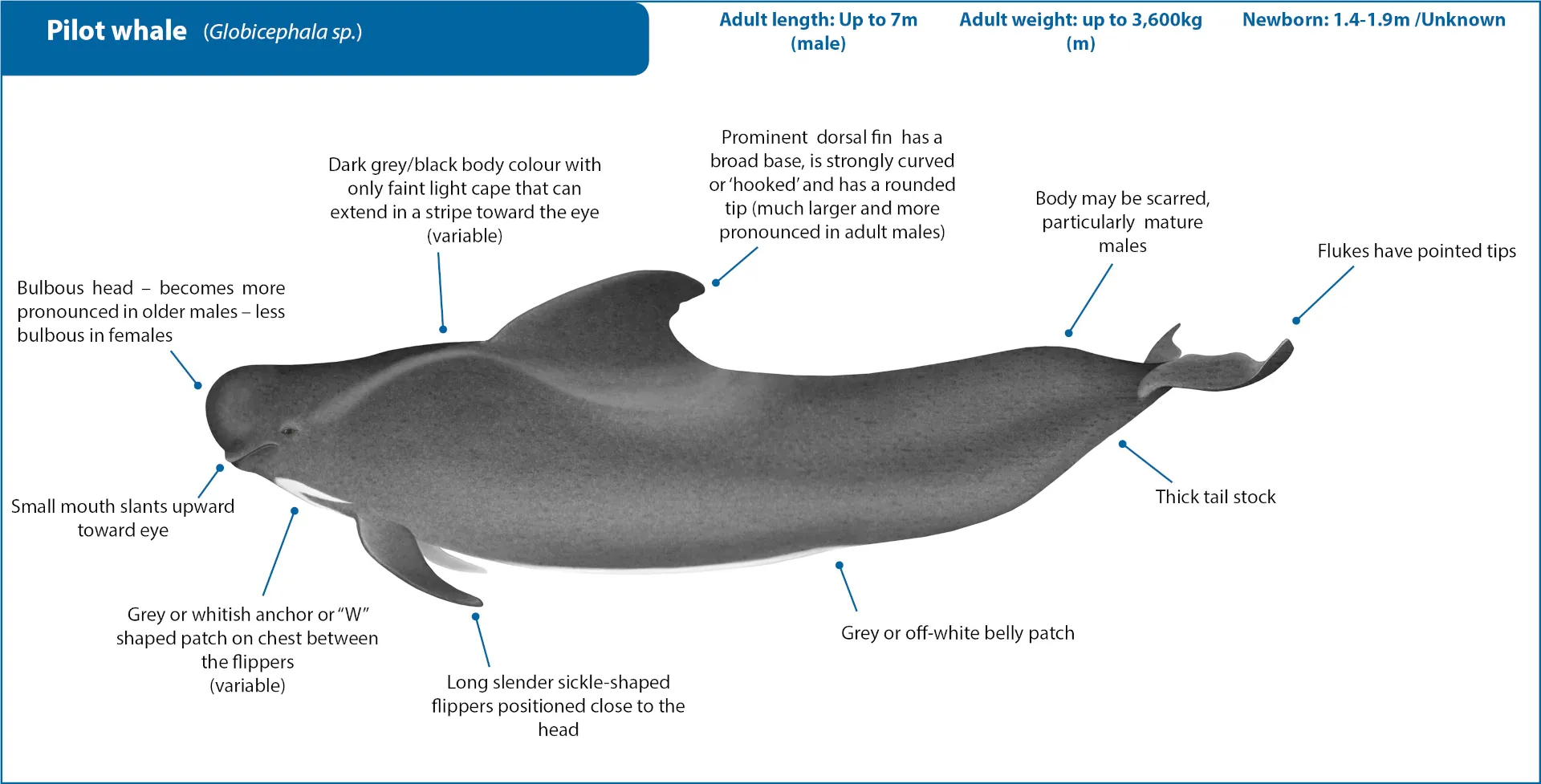
- Up to 6 metres long
- Rounded head
- Slate grey to black colour
- Low falcate dorsal fin
- Swims in large groups and prefers open and deep waters
The Pilot whale is an extremely social and gregarious species; the typical family unit contains between 30 – 80 individuals, though they are not particularly friendly with ships and do not ride bow waves. Normally they are not acrobatic, preferring to move slowly and “log” at the surface. Globicephala melas vocalises with highly distinctive clicks and whistles: listen to ♫ sounds of a Pilot whale.
Cuvier's beaked whale
Cuvier's Beaked whale Ziphius cavirostris is an Odontocete (Toothed whales and dolphins) an active hunter feeding on fish and squids. They tend to avoid boats, and dive for long periods, and are therefore seldom seen, except in strandings.

- Up to 6.5 meters long
- Head slopes to a short beak
- Coloured in a range of browns and greys with white marks
- Distinctive small dorsal fin
- Prefers deep waters
Cuvier's beaked whales have chunky, mottled bodies, with widely varying appearance, but all will display the distinctive beaked or pointed mouth. A single pair of forward-pointing teeth at the tip of the lower jaw erupt only in adult males, and may be exposed outside the closed mouth in large males. When diving it arches its back steeply before and may lift flukes above the surface.
Sperm whale
The Sperm whale Physeter macrocephalus or Physeter catodon has a huge, squarish head, wrinkled skin, a hump instead of a dorsal fin, and a notch in the middle of its tail. This cetacean's common name is derived from the milky wax substance in its head which early whalers likened to the fluid produced by the testes to carry sperm.
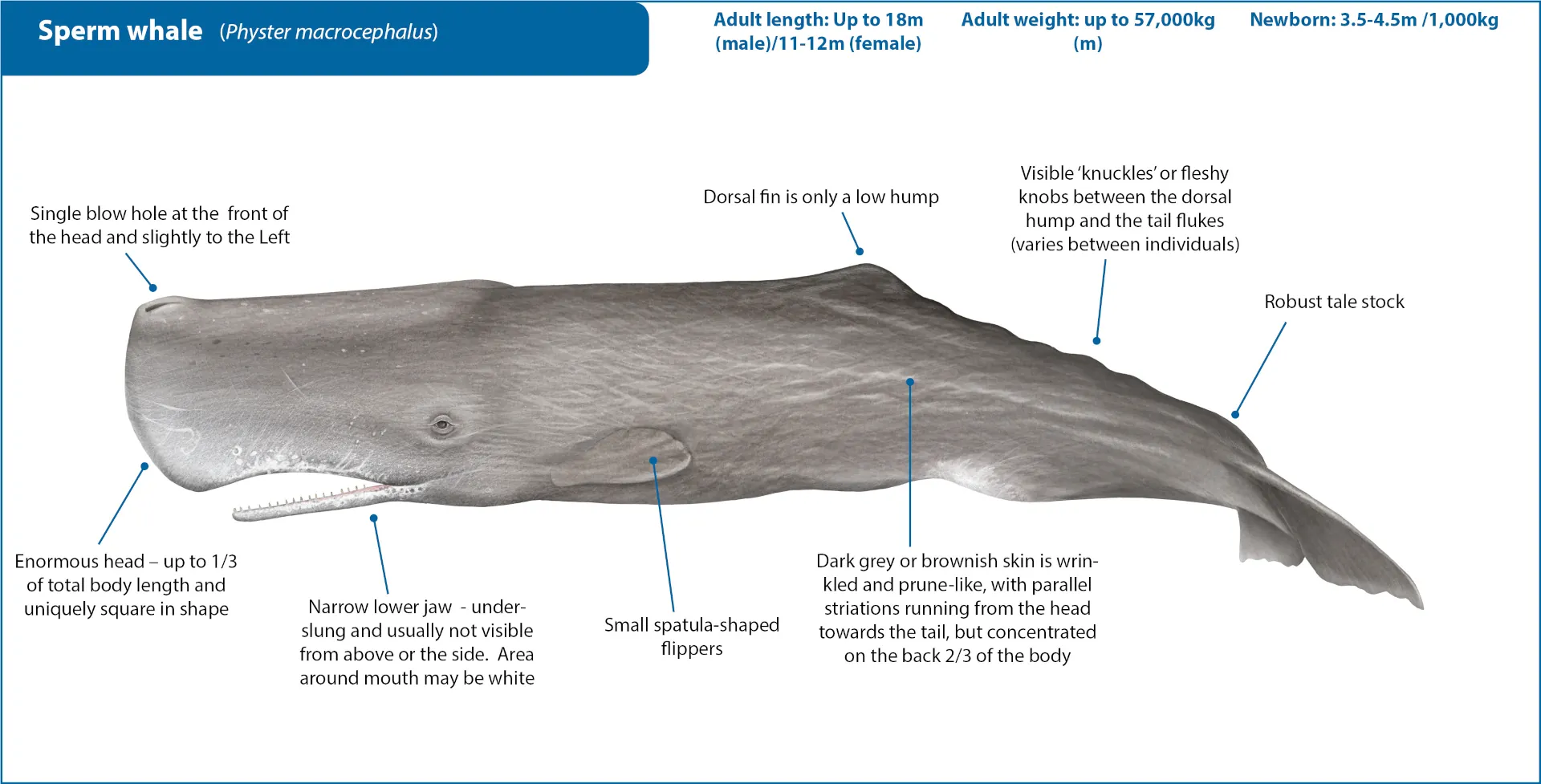
- Up to 18 meters long
- Large box head
- Dark grey to brown colour
- Small triangular hump and knuckles on the back
- Prefers deep waters
Their blow is one of the most recognisable of all cetaceans: single, bushy, about 5m and projecting to the forward-left of the animal. Sperm whales normally only venture close to shore when the depth of the water increases rapidly away from the coast (as it does around several Cycladic islands and the south of Crete). They communicate via pulsed clicks, and it has been theorised that some of these clicks are so powerful that they are used to stun their prey.
Fin whale
The Fin whale Balaenoptera physalus
is the only Mysticete, the Baleen whales suborder; from the Greek word meaning mustache, commonly sighted in Greece; besides an occasional Minke whale Balaenoptera acutorostrata.
It is the only asymmetrically coloured whale known: on the right side of the head the lips and part of the baleen are white or pale grey, yet the lips and baleen of the left side are all dark.
Another distinctive feature is its blow. Note that we can see the blow or spout of a large whale no matter what the air temperature is. The blow is a combination of highly compressed warm air, mixing with oil and moisture in the blowhole, as well as surrounding sea water and is coming out at about 400 km per hour! This is because whales exchange almost all the air in their lungs each time they breathe, about 85 – 90%, so they don't have to breathe as often as we do. We only exchange about 12 – 15% during each breath., which creates a tall, narrow column, between 4 and 6 metres high.
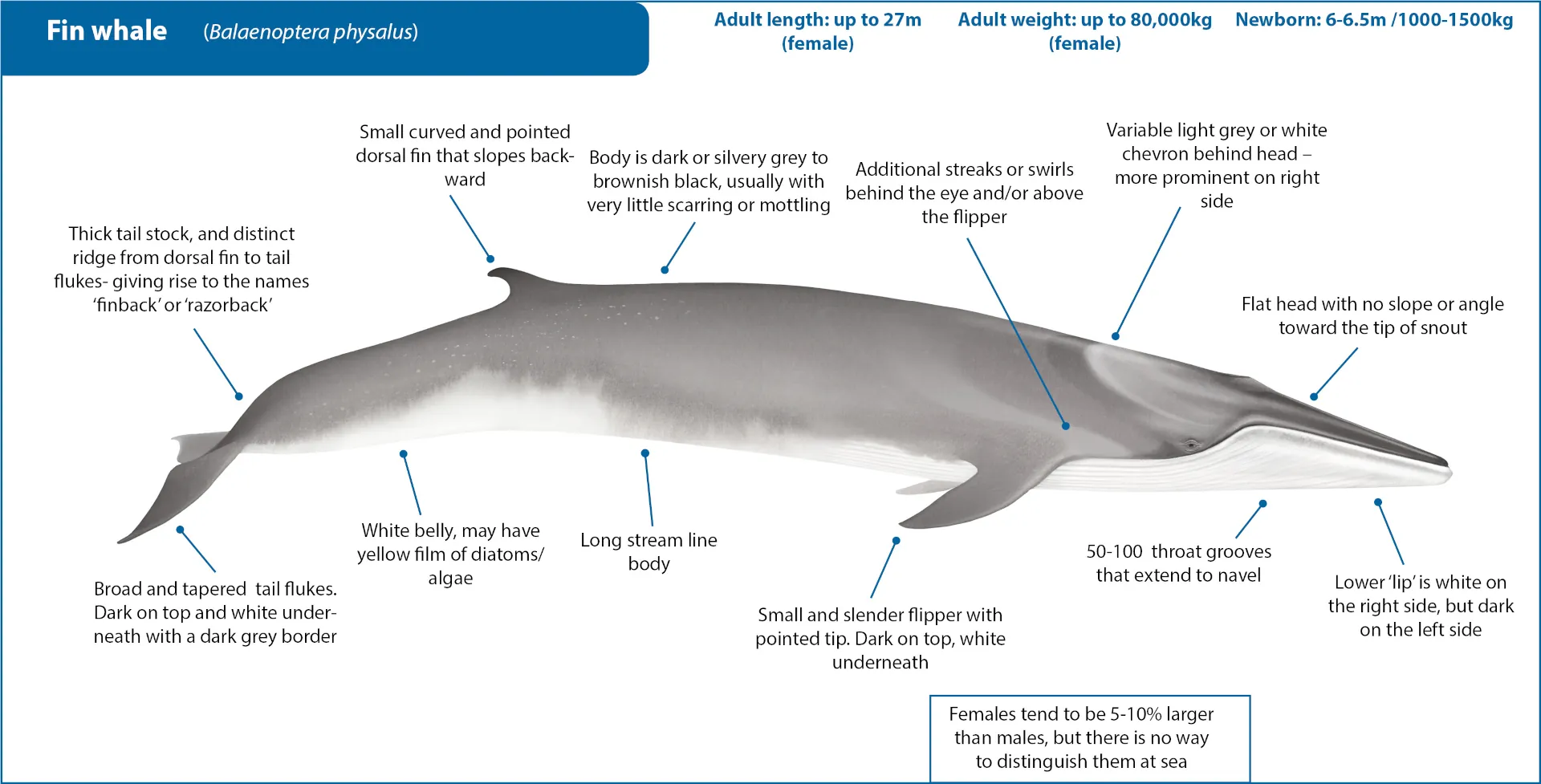
- Up to 20 meters long
- Dark grey, assym. coloured lips
- Small falcate dorsal fin
- Frequents open waters
- Gregarious. The usual pod size is 6 or 7 individuals
Identification Guide
Most cetaceans spend only limited time at the surface and even then they are only partly visible above the waterline or are travelling in a fast blur of froth. So, identifying the different Mediterranean whales and dolphins can be frustrating if you don't know what to look for. To help you cope with these limitations, the following guidelines – together with the characteristics described above – will help you distinguish between the different species of cetaceans found in Greece.


Dolphins are especially easy to recognise when they show (off) their typical behaviour: porpoising, see figure on the left.
The way they surface to breath, see figure on the right, also sets them apart from larger fish, like sharks, which have their tail fins vertically above the water. Most shark dorsal fins are shaped less falcate and more triangular. Moreover, at the surface these animals also show their vertical tail fin. Only mammals have horizontal tail fins (flukes).


Though risso's dolphins are much smaller than pilot whales, both lack the dolphin type beak and tend to log at the surface. Risso's dolphins often have their heads out of the water. You shouldn't see a blow or a “flukes up”, i.e. lifting its tail flukes above the surface when diving, with these two.
The most striking differences between these two cetaceans are:
- Scars: Risso's dolphins (especially older males) tend to be covered in scars, whereas pilot whales are darker and have no scars at all.
- Visible contours of body: The pilot whale is more rectangular and squad. Risso's dolphins are more curved, yet more "barrel-shaped" then other dolphins. The pilot whale's dorsal fin is typically pointing aft.
- Behaviour: Risso's dolphins are much more agile and playful, and – although both are very inquisitive – pilot whales are much less boisterous and Risso's dolphins are not interested in bowrides.


Finally, size matters and an animal larger than ten metres indicates either a Sperm whale or a Fin whale
The most striking differences between Sperm whale and Fin whale are:
- Blow: A blow that is projected forward-left indicates a Sperm whale. A vertical (narrow) blow indicates a Fin whale.
- Flukes: If the animal dives “flukes up” then again it is a Sperm whale. Have a look at some animated photos of this behaviour.
- Visible contours of body: Fin whales display a curved section of their body above the surface, contrary to Sperm whales, which resemble floating objects like containers or timber, with the blowhole and hump higher up at both ends.
- Number of blowholes: The Mysticeti (Fin whales) have two blowholes or nostrils, whereas the Odontoceti (Suborder of Toothed whales, such as Sperm whales, dolphins, Pilot whales etc.) have just one.
Test your knowledge
Now that you have studied these eight beautiful cetaceans in the Aegean / Ionian seas, be sure to test your knowledge on by answering the 12 questions of my
You'll be asked to identify these dolphins and whales, precisely under the conditions you're likely to encounter them yourself: during sailing cruises and yacht charters in the Greek water or the Turkish coasts (on gulets). Good luck!
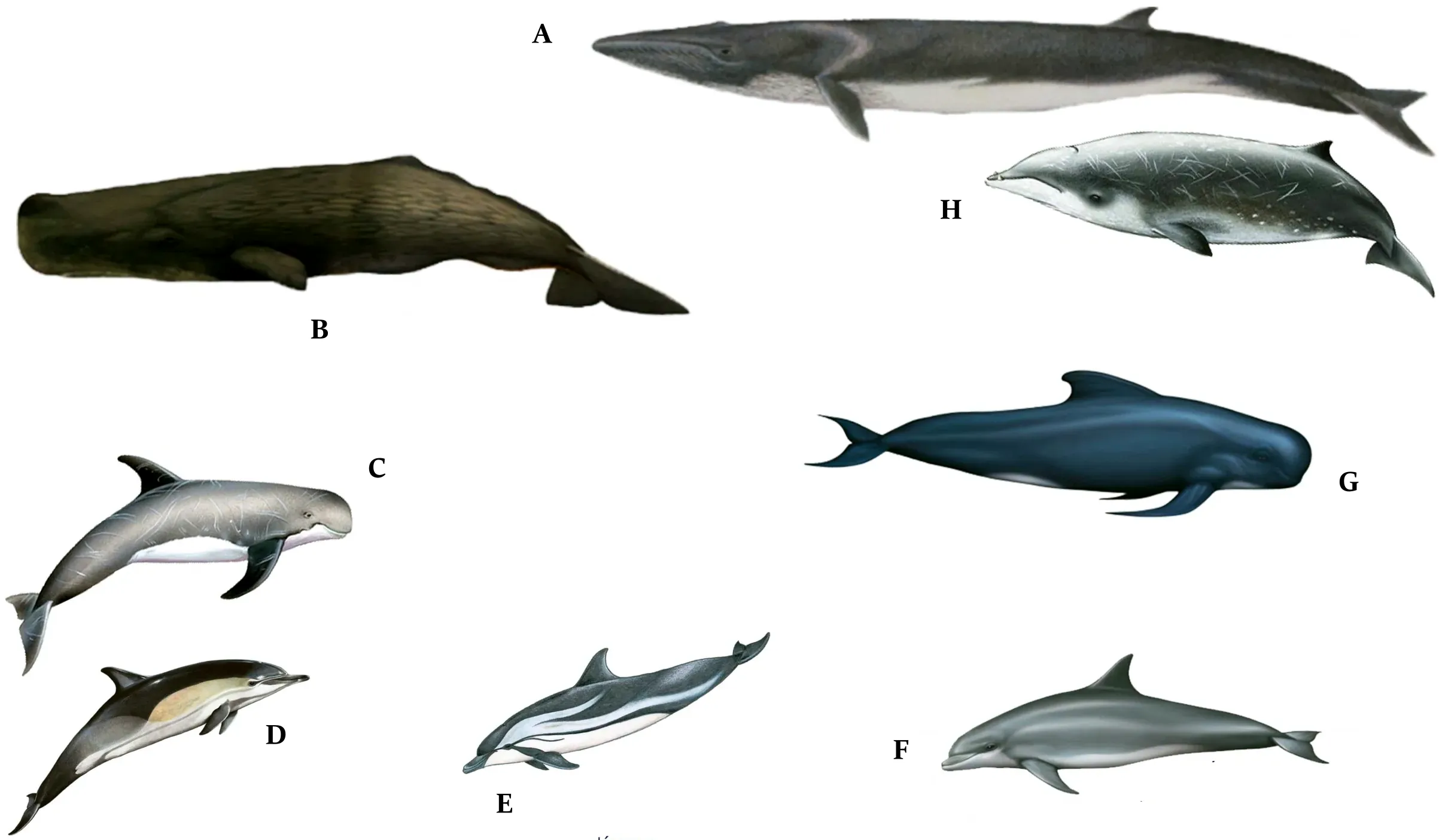
and the adjacent Carian and Lycian coasts of Turkey.
A – Fin whale
B – Sperm whale
C – Risso's dolphin
D – Common dolphin
E – Striped dolphin
F – Bottlenose dolphin
G – Pilot whale
H – Cuvier's beaked whale
Hi-res image

